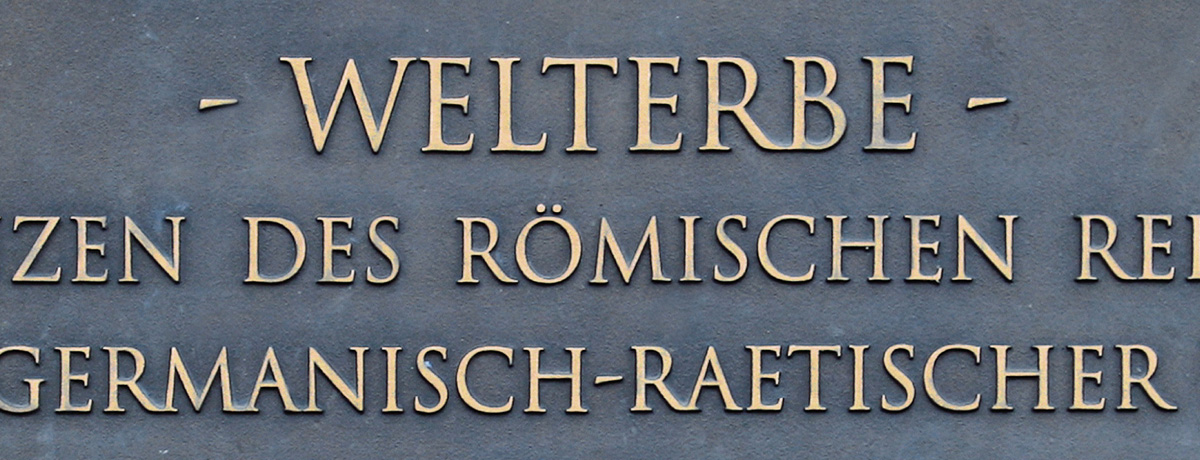PROTECTION, RESEARCH, MANAGEMENT AND PRESENTATION OF THE LIMES IN GERMANY
Founded in Esslingen in 2003, the German Limes Commission (DLK – Deutsche Limeskommission) is the point of contact for all activities relating to protection, research and scientific presentation of the Upper German-Raetian Limes.
Following the inclusion of the Limes on the list of UNESCO World Heritage Sites in 2005, comes the additional responsibilities to help ensure international standards in the care and management of Germany’s largest and best-known archaeological monuments.
Tasks include:
- Recommendations for the presentation of the individual components of the Limes
- Consultation on all projects conveying the Limes to the public
- Coordination and implementation of research projects
- Provision of expert information within the Limes database
The responsibilities of the DLK can essentially be summarised with four key words, “protection, research, management, and presentation” of the World Heritage Site of the “Upper German-Raetian Limes” in Germany.
The protection of cultural heritage is the highest priority in accordance with the World Heritage Convention of 1972. Accordingly, not only do the monument protection laws of the federal states apply, but it is also essential to be involved in the planning of projects at an early stage. In this regard, the DLK provides specialist information within the Limes database that planners can access and make the necessary adjustments to their plans with consideration of the World Heritage Site. Furthermore, the DLK provides additional recommendations regarding the conservation of the monument.
The research of the Upper German-Raetian Limes has a long history dating back to the 18th century and the Imperial Limes Commission. Their results, published as a series titled “the Upper German-Raetian Limes of the Roman Empire”, still form the basis for modern research of the Limes in Germany today. Even after the work of the Imperial Limes Commission, excavations and scientific research on the ORL (Upper German-Raetian Limes) did not cease, but there was a lack of a unifying authority to coordinate and bring both researchers and research together. In the course of the preparations for the nomination of the ORL to UNESCO, two scientific conferences were organised in 2000 and 2001. After the foundation of the DLK in 2005, these scientific conferences have been made a consistent component of the organisation and have been regularly organised by the DLK every two years with the ORL or the Limes in general as the primary topic of discussion. The conferences serve as a forum for researchers to present and exchange their latest research and results. Through their publications in the “World Heritage Site Limes” (Beiträgen zum Welterbe Limes), those interested in the public community can participate and stay informed. The open events are supplemented by workshops dedicated to more specific topics.
Another aspect of research since 2010 has been the promotion of young academics through the permanent awarding of regular scholarships, which is further supplemented with additional oustanding scholarships.
Another important task with regard to such an extensive World Heritage Site is its management. Not only is it essential to have a regularly updated management plan prepared, but it is also necessary to establish effective monitoring of the archaeological monument and make preparations regarding risk management. On an international level, the exchange with colleagues and partner sites of the “Frontiers of the Roman Empire” is essential, not least of which is to exchange “best practice” experiences relating to management within the Management Group. As a serial transnational World Heritage site, collective responsibilities, such as the “Periodic Reporting” required by UNESCO, must also be collaboratively managed.
However, all of these outlined tasks do not serve an end in and of themselves. The goal of the World Heritage Convention is to protect exceptional cultural heritage so that it can be preserved for future generations. It is made clear in this last statement that the target audience of these endeavours is the public. It is therefore an additionally crucial and fundamental responsibility of the DLK to oversee the communication and presentation of the Upper German-Raetian Limes. The necessary cooperation of numerous partners cannot be understated. Therefore, the DLK offers expert advice for all projects regarding their communication to the public. Since the establishment of the DLK, it has been possible to achieve a uniform public image of the ORL through concrete specifications in the guidelines for signage along the Limes. Moreover, the World Heritage Site is explained on site of the archaeological Monuments through a group of volunteer guides, the “Limes Cicerones”, who are supervised and trained by the DLK.
Another important aspect of the work of the DLK is the publication of results from the latest research being undertaken. For this purpose, the DLK has two publication outlets at its disposal. The first is the aforementioned publication series, “World Heritage Site Limes” (Beiträgen zum Welterbe Limes), relating to the colloquia and thematic workshops. The second is the news bulletin titled “DER LIMES”, which has been published semi-annually since 2007 having undergone a fundamental relaunch in 2008. The “DER LIMES” publication presents current and ongoing research on the Limes in a way that is both comprehensible to a general public yet interesting and engaging for experts alike.


